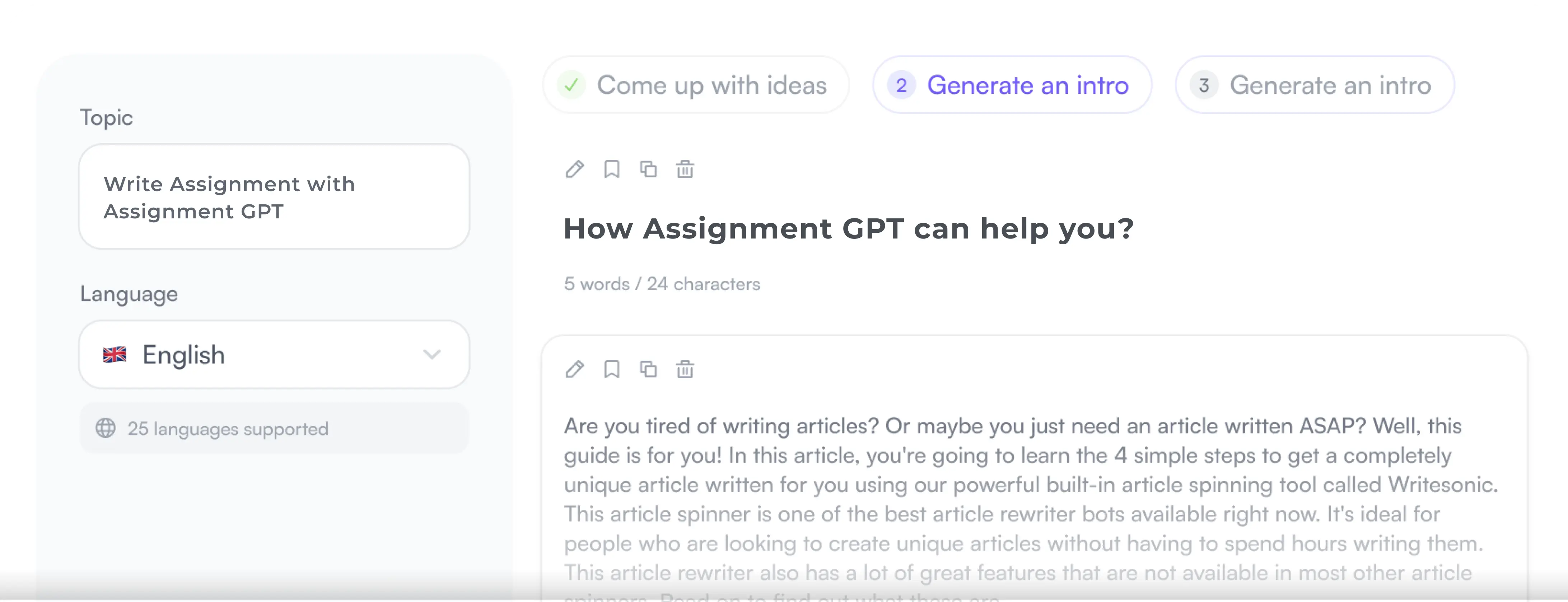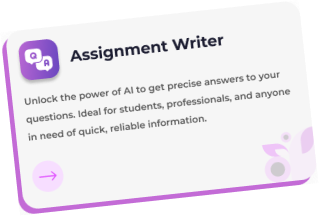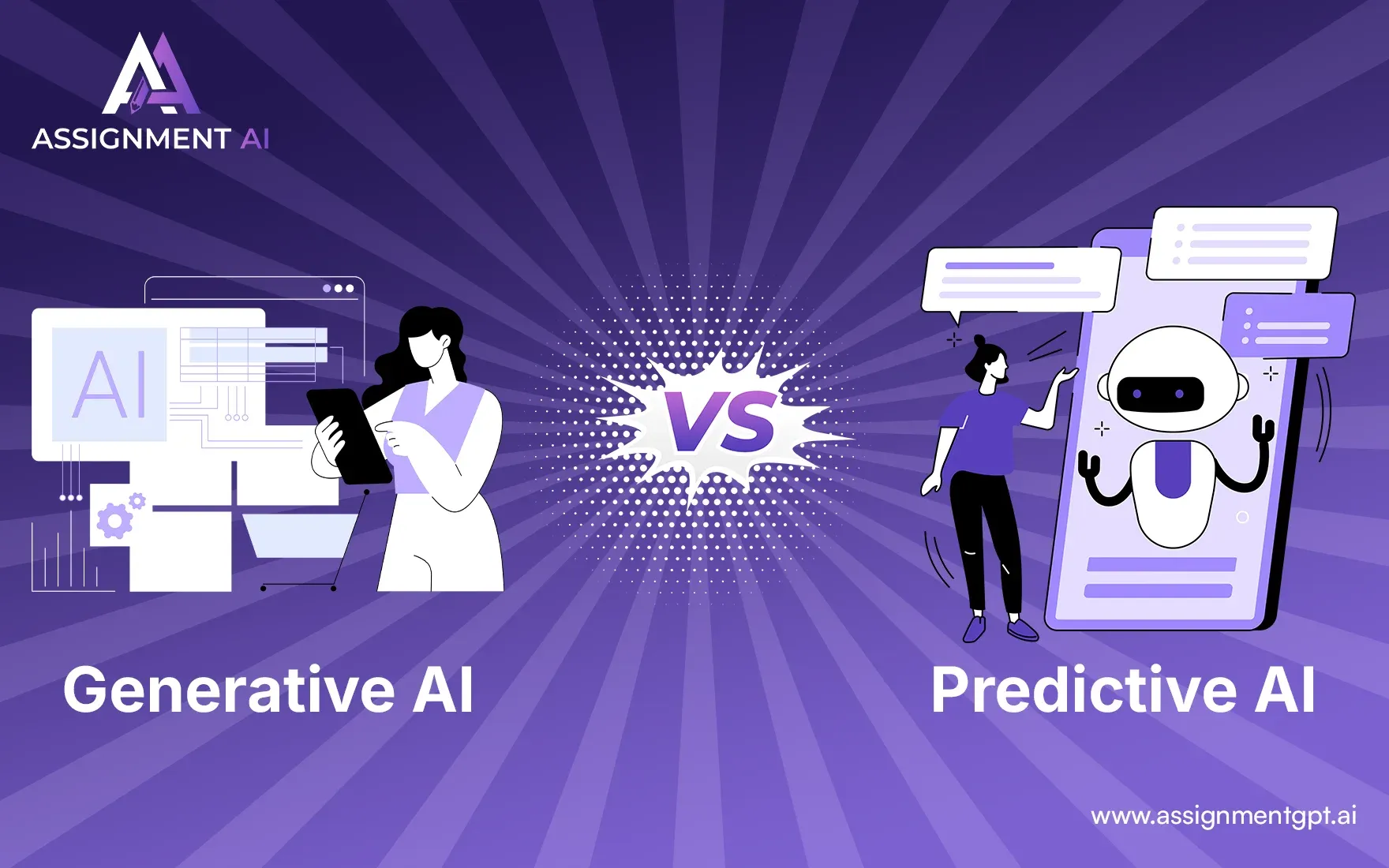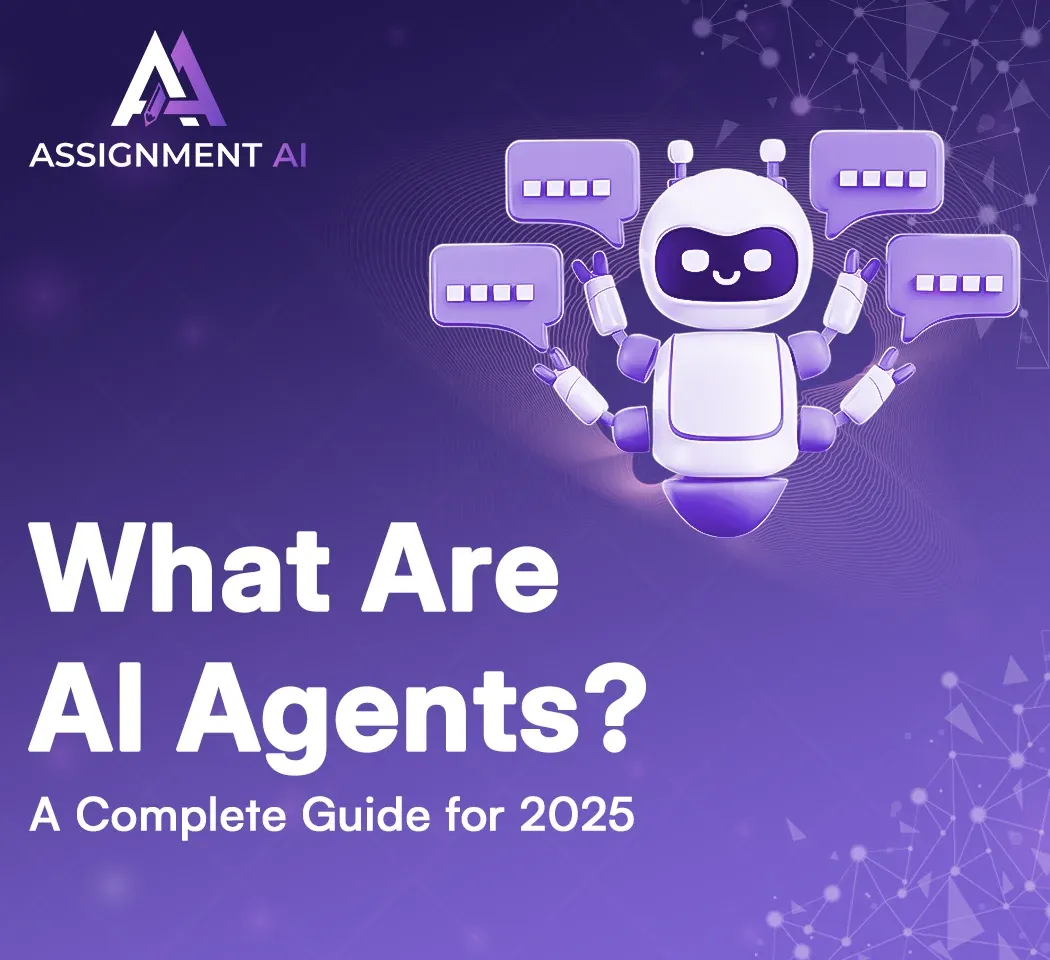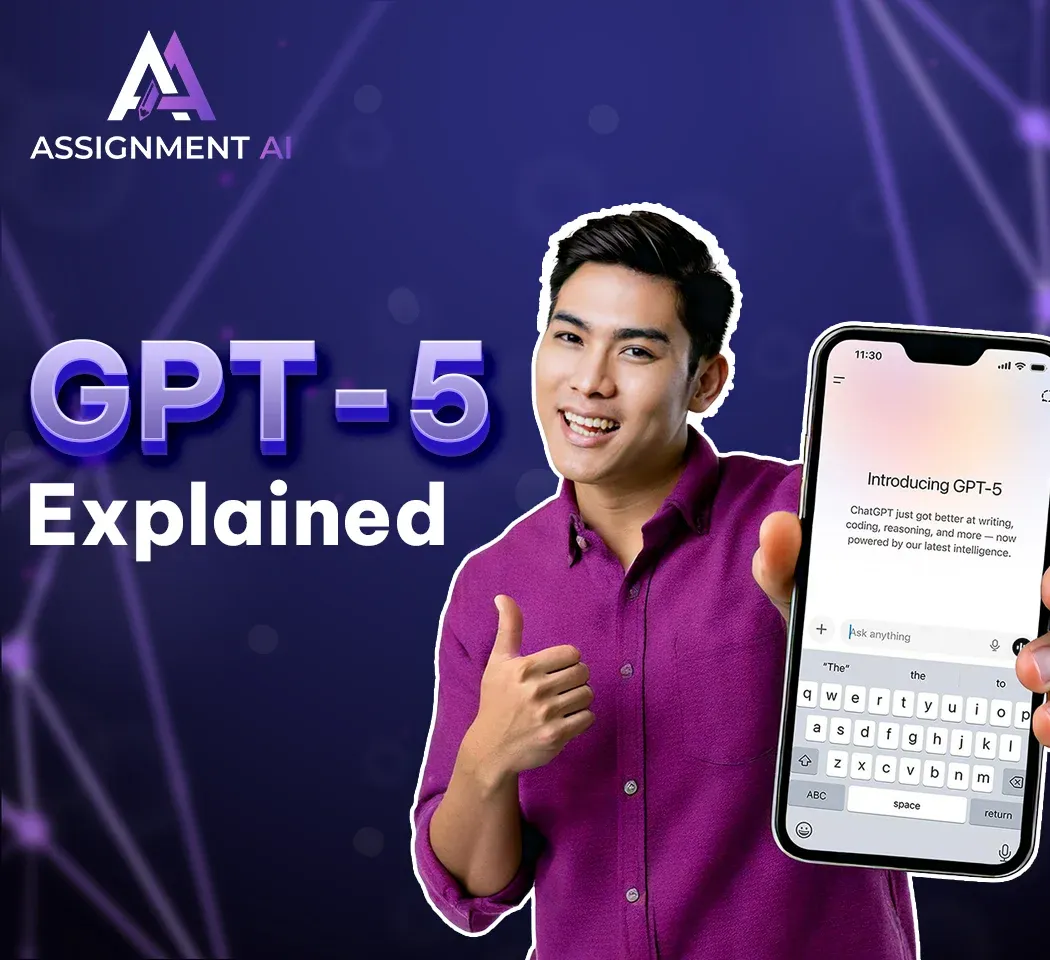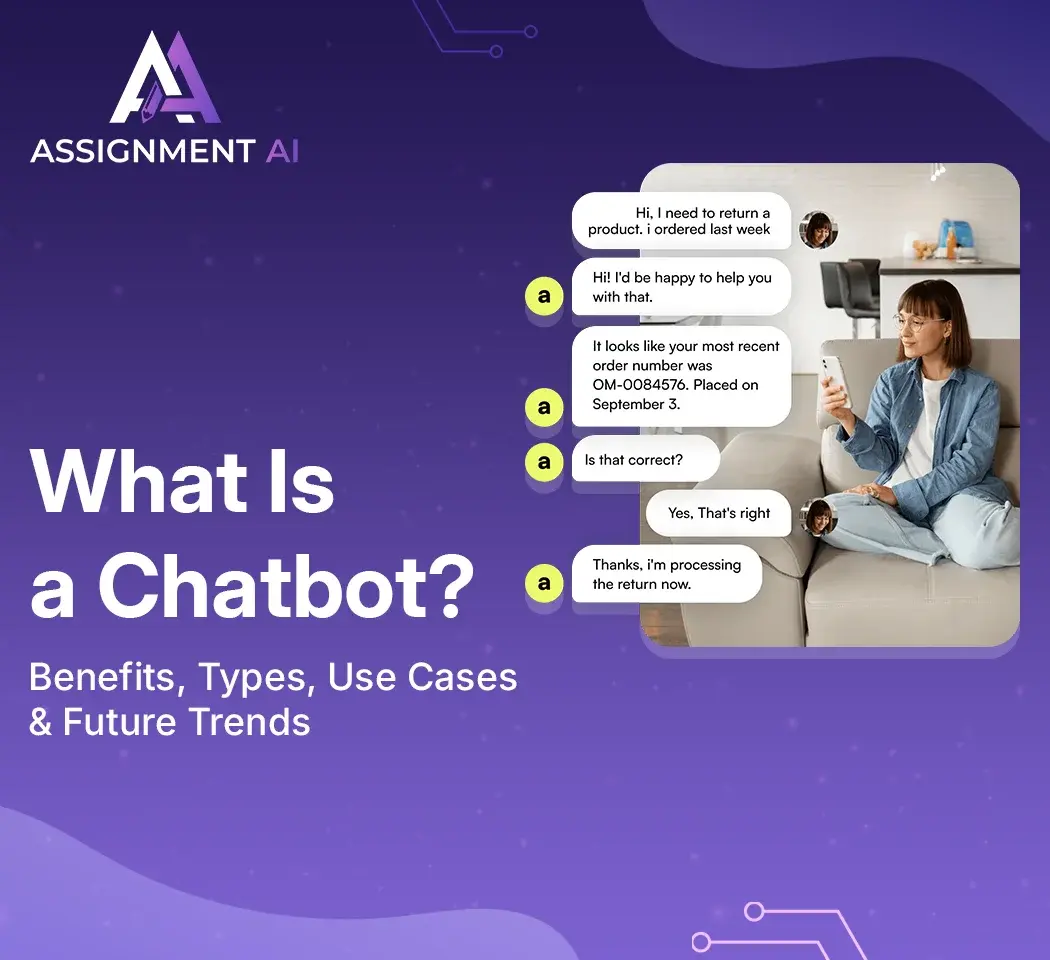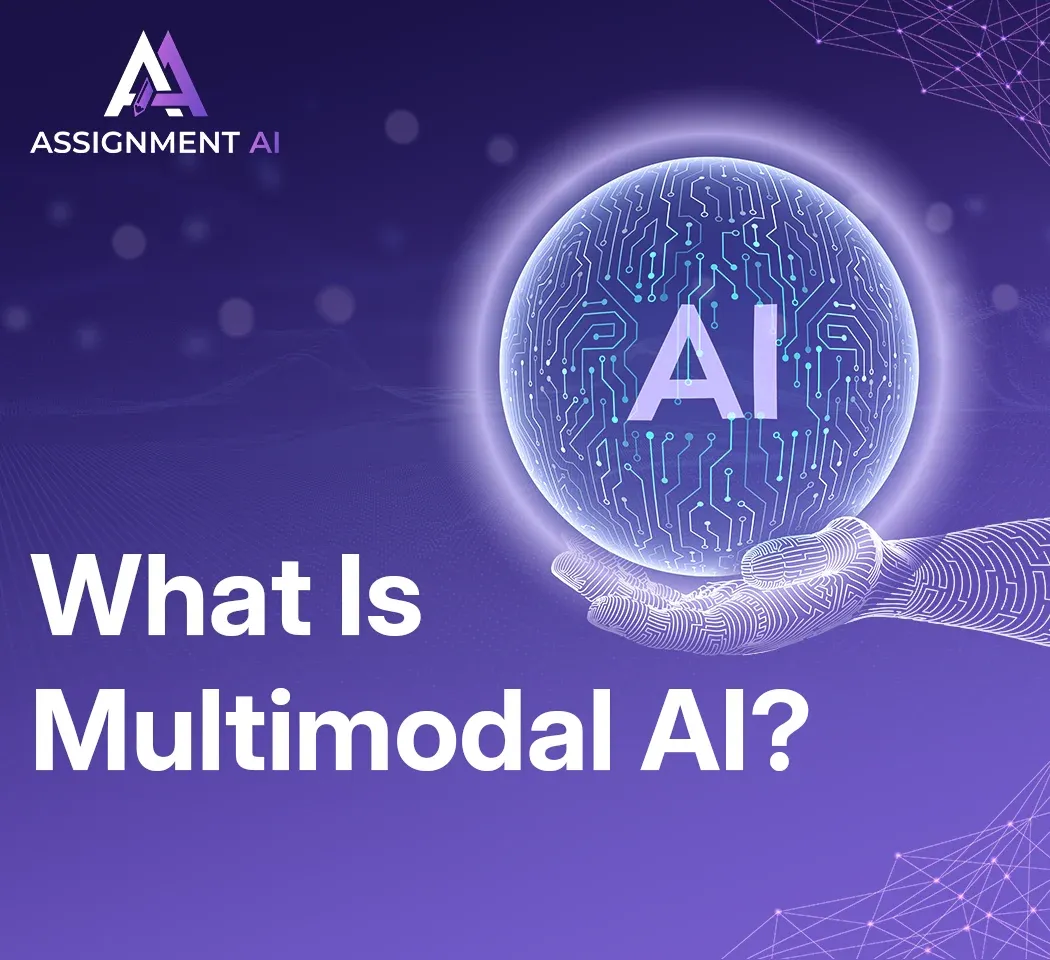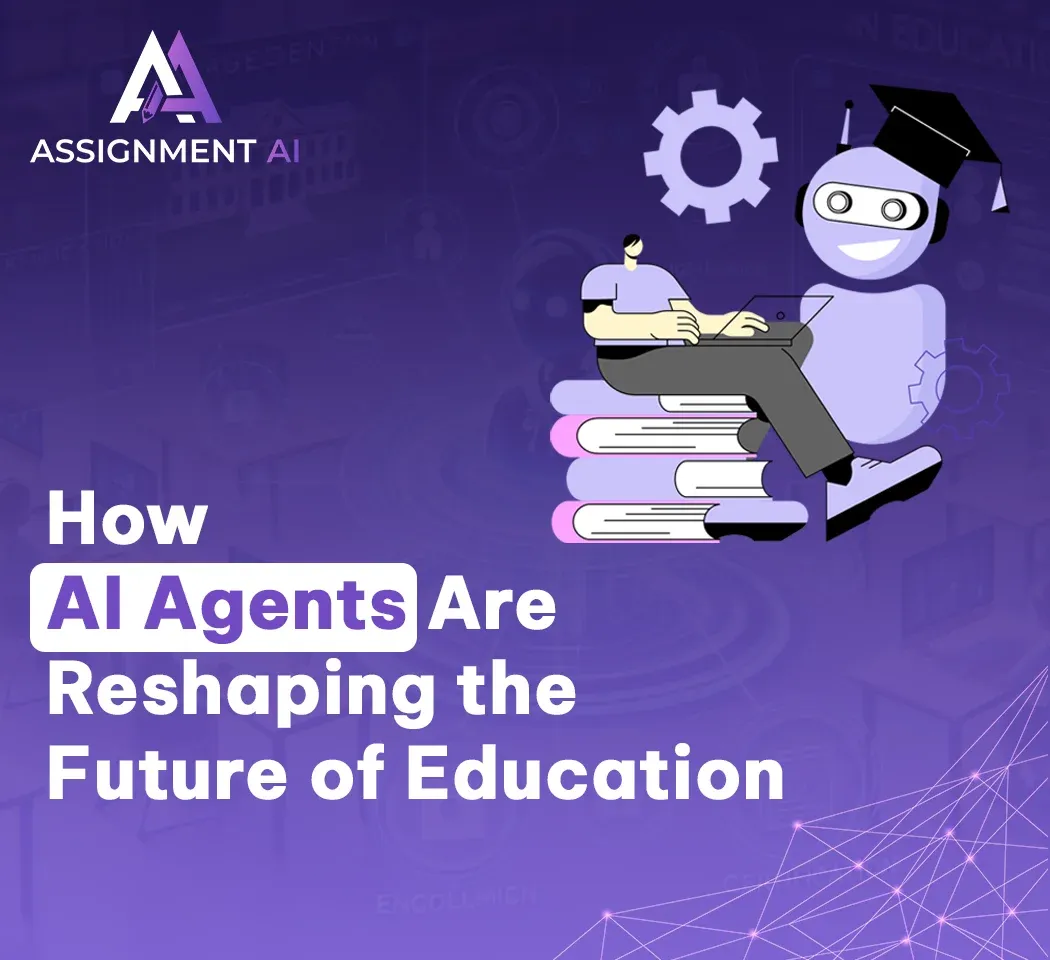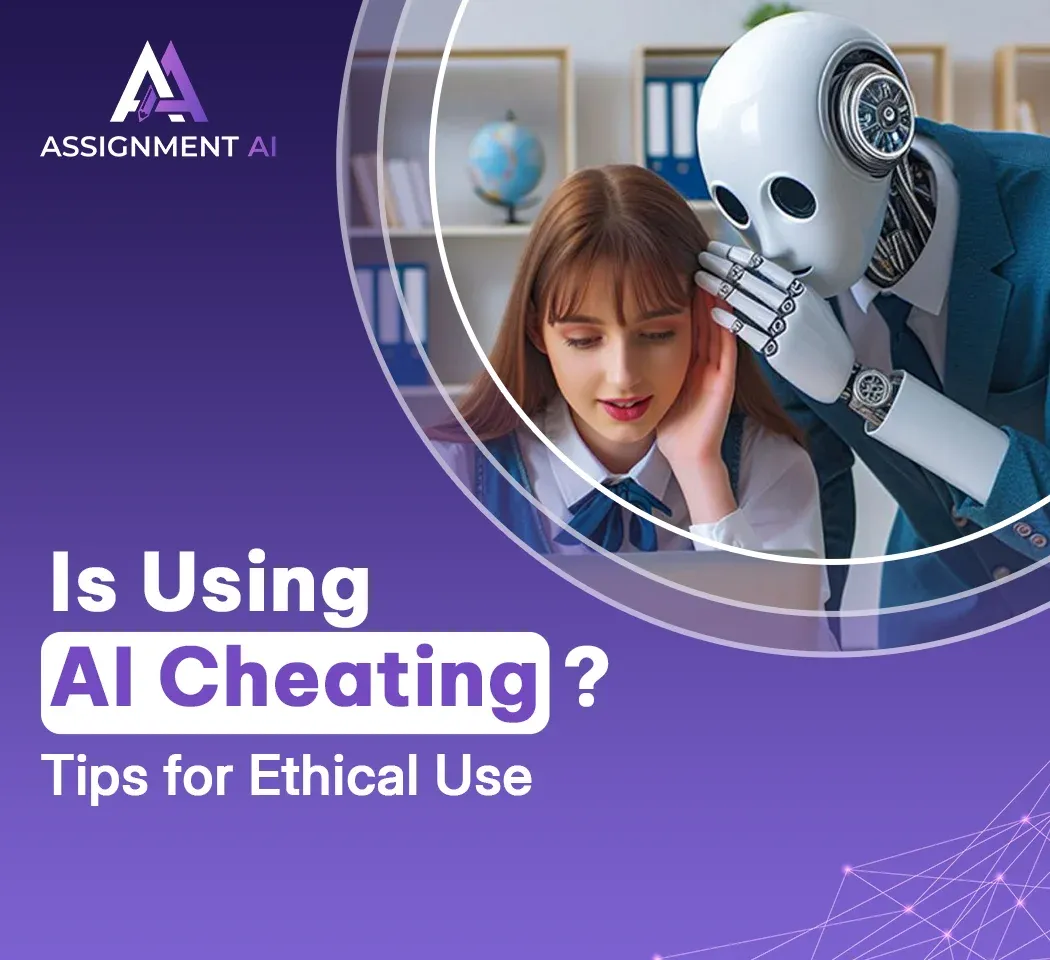AssignmentGPT Blogs
Suppose if you are a stock market investor, due to which you already spend your whole day in making share market strategy, future predictions and it is also quite a headache and one day your daughter tells you that she needs help with a school homework in which she has to write an essay, then it will be very difficult for you to take out time from your busy schedule and help her, but if I tell you that you can easily complete both these tasks by using AI, then you will also say that it is not possible, but let me tell you that with the important subset of Artificial Intelligence, you can easily complete your share market prediction and your daughter's essay writing. And the names of both those AIs are Generative AI and Predictive AI.
Both these AI technologies are reshaping the industries as it is being used a lot in education, professional sectors and daily life. But still there are many people who do not have a deep understanding about Generative AI and Predictive AI, and also do not know how it is used. So, to solve this problem, we will discuss this topic in detail so that you can use both of them in real-world problems.
Quick Summary
Generative AI and Predictive AI are subsets of Artificial Intelligence. Generative AI is an expert for creative tasks wherein it can understand (text, images, audio, etc.) and give the result in the user’s favourite format.
Predictive AI uses historical data to predict future outcomes and, situation of any sector or topic.
These two AI technologies are used in different sectors. Generative AI is used a lot in the education and copywriting sectors, and predictive AI is used in prediction-based industries. Stock markets and real estate are its best examples.
What is Generative AI?
Generative AI is a subset of artificial intelligence that specializes in creating new content. This can include anything from text and images to music, video, or code. For example, if you give input in audio format to a generative AI platform and ask for results in image or text format, it can easily give you results in these formats. Generative AI has the capabilities of giving unique and human-like creation or response.
It relies heavily on machine learning, especially deep learning models such as transformers and generative adversarial networks (GANs). All these models depend on large datasets, due to which they already have a lot of data available, which helps them understand human input and give unique output accordingly.
Popular examples: ChatGPT, DALL-E, Midjourney, AssignmentGpt Ai and GitHub Copilot.
What is Generative AI Used For?
Generative AI is used for many tasks like writing blogs, emails, and essays. Apart from this, you can also use it for logo designing, art designing, music composing, and video editing. Apart from this, if you are a coder or a software developer, you can use it for code generation. It can also simulate gaming environments very well. You can also use it to train your models. Generative AI is mostly used for content-heavy industries and creative fields.
Advantages of Generative AI
Generative AI is used in many creative sectors, like copywriting and artistic projects. There are very few sectors, but apart from this, Generative AI is used at many micro-level industries too. Let's know about the advantages of Generative AI so that you have an idea of what benefits you will get if you use it in your sector.
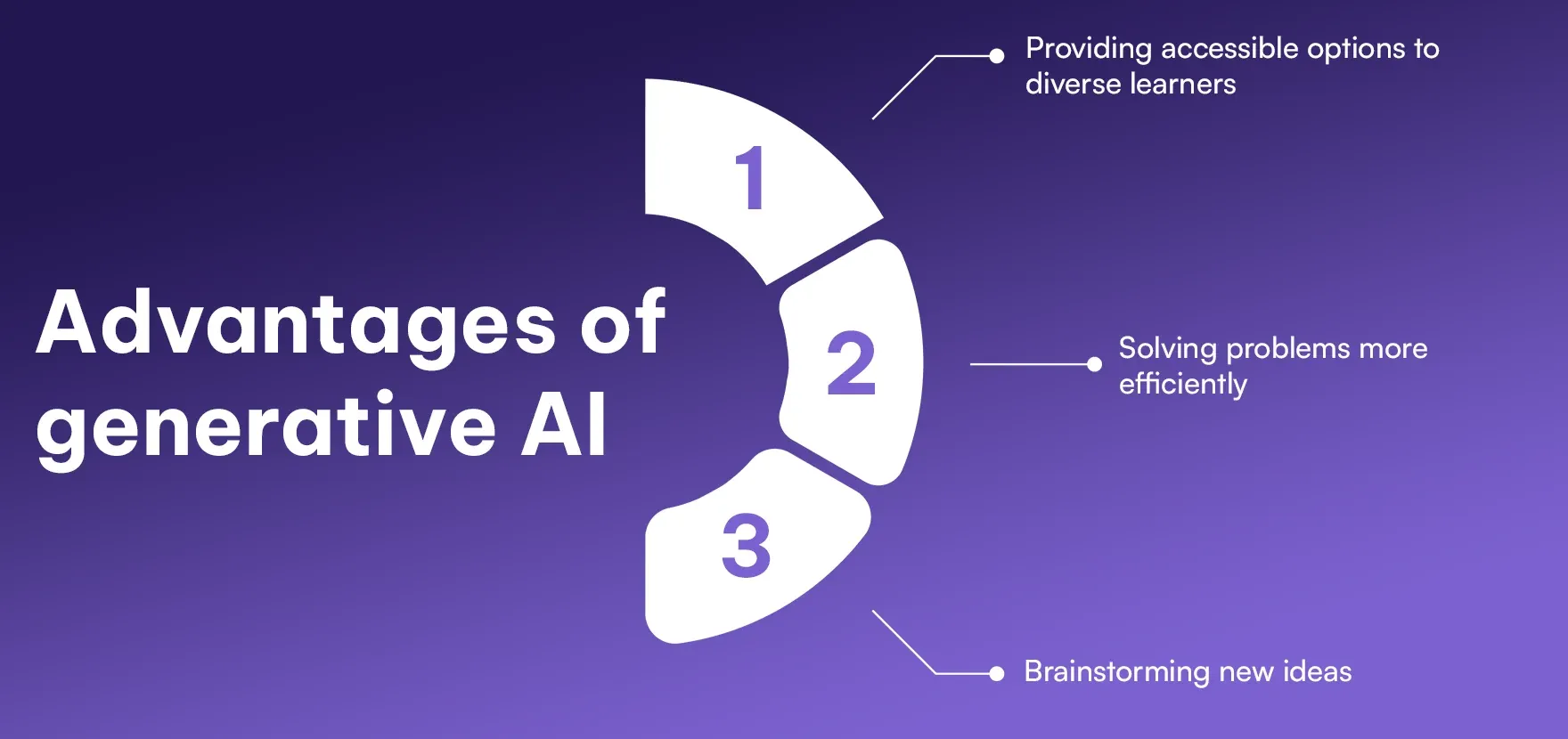
Learners: Generative AI tailors content for different learning styles, which helps students, professionals, and global audiences engage better. It gives them personalized results and study material, which helps them improve their weak points, and their engagement is also very good due to personalization of study. Generative AI is best for visual learning as it can give AI-generated diagrams, audio results, and detailed text results. Apart from this, it can also create a summary of your complex books.
Solving problems more efficiently: Tasks like debugging, creating code snippets, or summarizing meetings can be done very well by the tools of generative AI, which saves your time and reduces the chances of errors.
Brainstorming new ideas: Whether you need a headline for your article or you need an idea on a topic, generative AI is perfect for this work; it can give you great ideas in seconds. That's why writers, marketers, and developers use it a lot.
Disadvantages of Generative AI
We have discussed enough about the advantages of Generative AI, now let's know about its disadvantages as well.

Academic dishonesty and plagiarism: When students or professionals rely on AI to complete tasks dishonestly, it can lead to serious ethical concerns and quality degradation. The main aim of the academic sector is to test the skills of the students, but when students use it to cheat, it leads to even more ethical concerns.
Public and private security risks: Generative AI can replicate personal or confidential data if not carefully monitored. It can also generate malicious code or fake content. Deepfakes and fake government documents have also been made possible due to Generative AI, which is a very concerning problem.
Poor data quality: If the training data is biased, incomplete, or inaccurate, the generated content will reflect those flaws, sometimes leading to misinformation or even copyright issues. As we already know that Generative AI generates new content according to the available data, so many experts say that it only tries to give new output by mixing many results; it cannot provide unique content as it does not have thinking capabilities like humans.
Also read this article : 7 Branches of Artificial Intelligence You Should Know
What is Predictive AI?
Predictive AI uses statistical models and machine learning to analyze historical data, it predicts future events by considering past market trends, news, situations, its main focus is on insights and probabilities. Predictive models try to learn patterns and give high priority to the relationships of these datasets and use them to predict market behaviors, risks, and trends.
Examples: Netflix and YouTube recommendations, stock price forecasting, health diagnostics, and credit scoring.
What is Predictive AI Used For?
Predictive AI is mostly used for predictive sectors like forecasting sales or market trends, giving personalized product or content recommendations, YouTube content recommendations, and Amazon product suggestions are some of the best examples. It also plays an important role in detecting equipment failures beforehand.
Predictive AI is also used in real-time fraud detection because whenever it detects anomalies in a financial transaction, it can perform activities like freezing the transaction or account or failing the transaction so that fraudulent activities can be avoided. It is also used a lot in managing inventory and supply chains so that demand and supply can be managed. Sending notifications and emails to customers according to their behaviour has also become possible to a large extent due to Predictive AI.
Advantages of Predictive AI
To understand Predictive AI in more detail, let’s learn about its advantages, in which we will try to know about all the important advantages and why it is used.
Predicting human needs: Predictive AI gives best actions and recommendations regarding health risks and all these recommendations are according to historical medical research papers and reports, and quite predictive AI also gives real-time and personalized reports, due to which it can prove to be quite revolutionary in the healthcare sector.
Providing more time for employees to focus on decision-making and complex tasks: Predictive AI can handle repetitive data-related tasks quite easily, in which doing data-heavy analysis is a matter of minutes. By using this, human workers can keep their focus on innovation and strategy.
Disadvantages of Predictive AI
Whenever probability and prediction are used, it can never be 100% accurate and real market scenarios can change or fluctuate, so no matter how perfect the analysis is, Predictive AI still has many disadvantages.
Requires massive amounts of high-quality data: Predictive models need large datasets to find patterns and such models in which limited, poor or insufficient data is used in training, can make unreliable predictions.
Lacks absolute certainty: As we know, predictions are probabilistic. They can only help you guide decisions but can never guarantee outcomes due to unpredictable variables. So it can be risky to rely mostly on predictive AI platforms.
What’s the Difference Between Generative AI and Predictive AI
Although both models are used for different sectors and different tasks, let us know about the differences between Generative AI and Predictive AI.
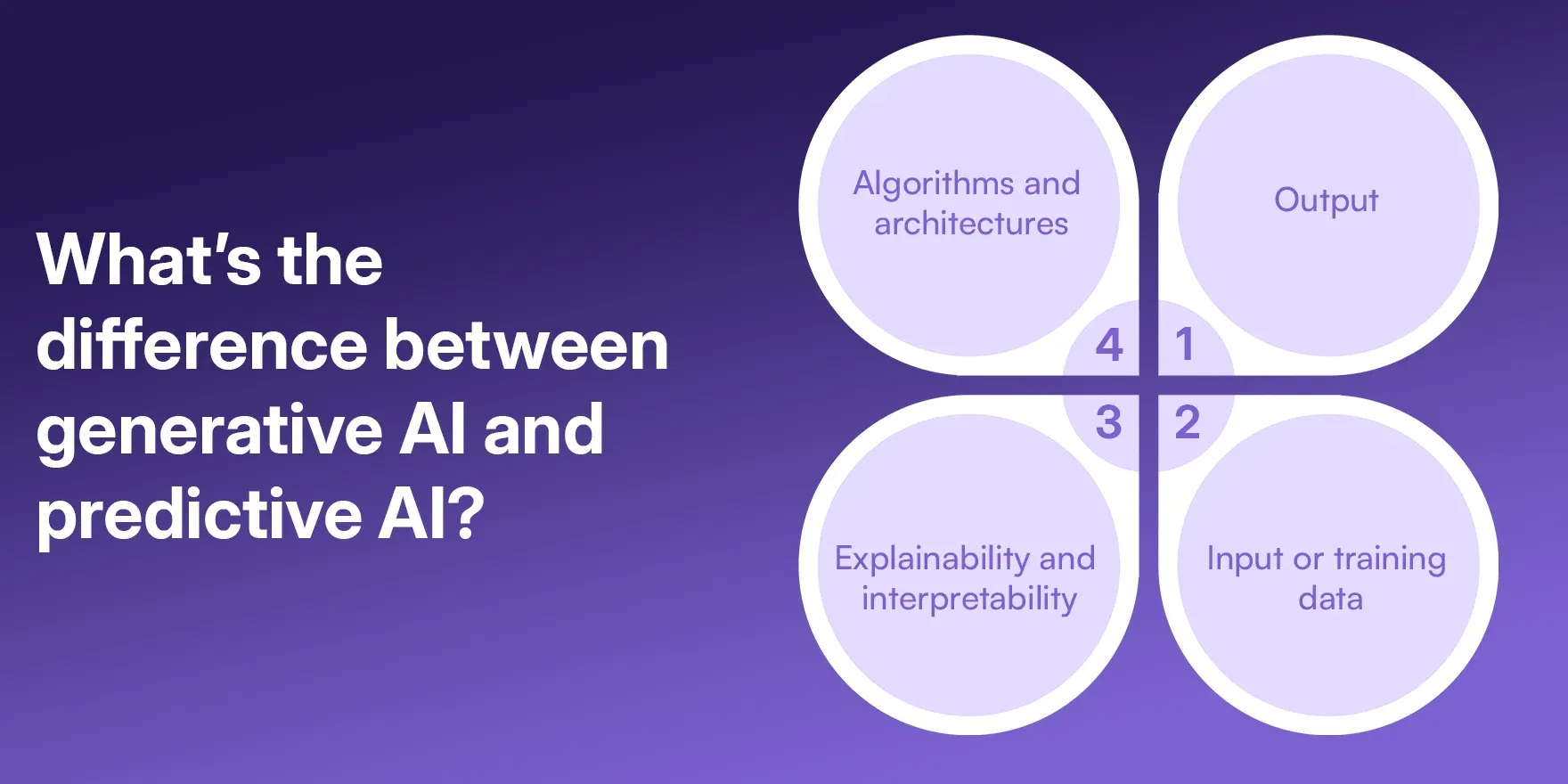
1. Output
Generative AI tries to create new and unique content, and that content can be in text, images, and audio formats. Popular and advanced Generative AI platforms have the capabilities to create unique content.
Predictive AI works on probability, it tries to make predictions of the most accurate possibilities according to historical data, trends, and current scenarios.
2. Input or Training Data
Generative AI is trained on broad datasets like text corpora, image libraries, or audio samples. Apart from this, many advanced platforms also use data from big platforms like YouTube for training their models.
Predictive AI relies heavily on historical data, structured datasets, or scenarios data. The more data it has for training, the more scientific and closer to probability its predictions will be.
3. Explainability and Interpretability
Generative models are often opaque and hard to interpret, so it is often difficult to tell on the basis of which idea or source Generative AI has given an output.
Predictive models are based on statistics, due to which its results are quite explainable, which makes it quite easy for most people to understand.
4. Algorithms and Architectures
Generative AI: GANs, VAEs, transformers, diffusion models are used to create popular generative AI platforms such as ChatGPT.
Predictive AI: Regression models, decision trees, random forests, time-series models are majorly used in Predictive AI, the rest can vary from platform to platform.
Generative AI vs. Predictive AI Use Cases
Let us learn about the use cases of Generative AI and Predictive AI and also try to know in which sector it is primarily used.
Generative AI Use Cases
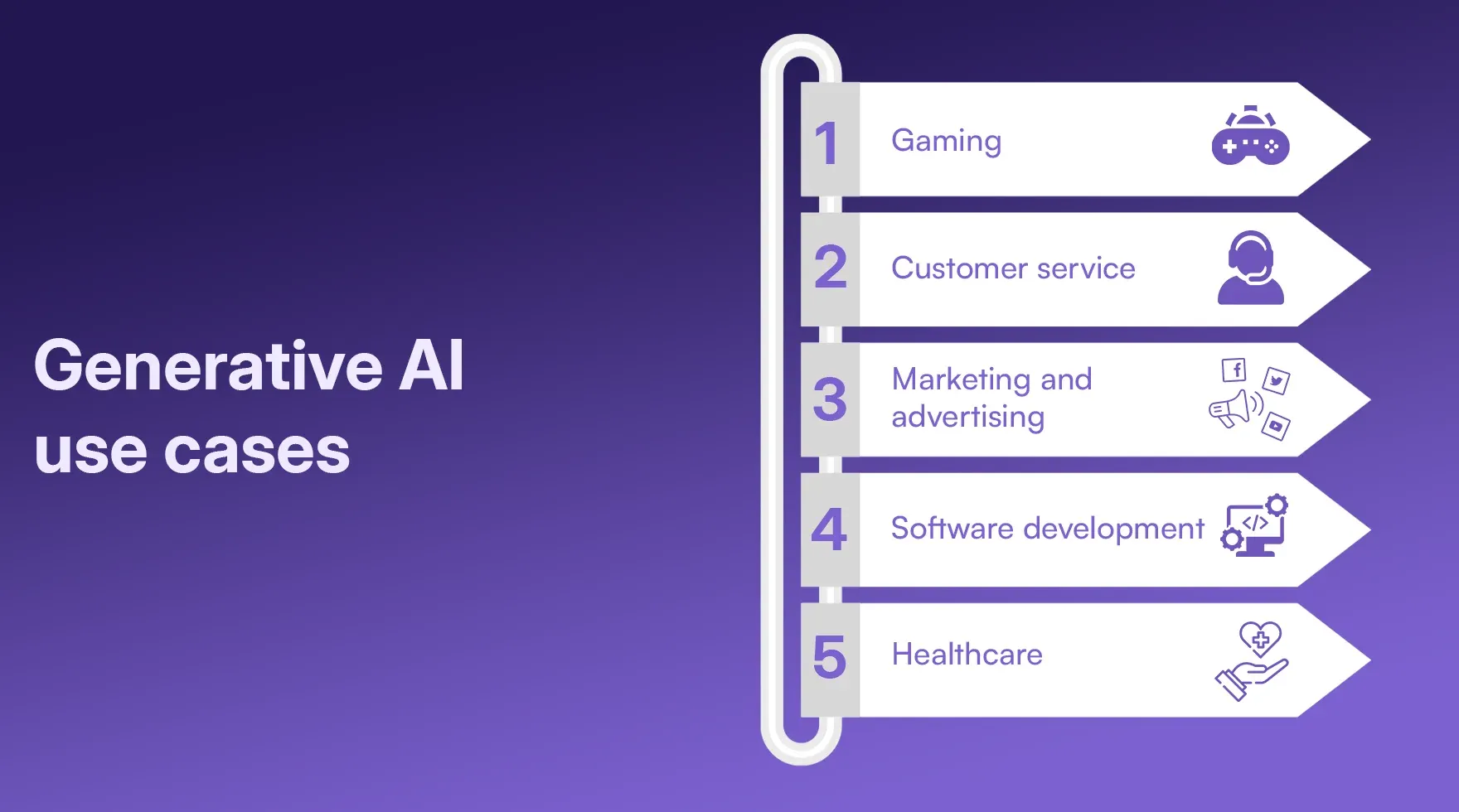
Gaming: Generative AI is used for a lot of creative tasks in the gaming sector where character and environment designing is important and it is also used by many UI designers for narrative design.
Customer service: Companies use Generative AI integrated Chatbots to give a human executive-like experience for FAQs answering or generating replies.
Marketing and advertising: Generative AI is used a lot for copywriting, ad creation, brand visuals so that advertising campaigns can be made more engaging and it also improves marketing a lot.
Software development: Generative AI is also very perfect in auto code generation and bug fixing, so developers use it a lot in their projects.
Healthcare: It is also making a great contribution in the healthcare sector, as it is being used to create synthetic data for training and generate molecules for drug discovery.
Read More : What Is Multimodal AI?
Predictive AI Use Cases

Fraud detection: Predictive AI is being used a lot to track fraudulent activities, because it can temporarily block any irregular financial behavior it spots, that too in real time, so that manual staff can review it as quickly as possible and if there is a problem, action like freezing the account can be taken.
Financial forecasting: It is used a lot for stock market prediction as it is used for revenue prediction, expenses, and market trends.
Supply chain management: Predictive AI balances demand and supply very well, which benefits both consumers and companies, and the company does not have to keep a large storehouse to store the product in advance. And this also optimizes logistics to a great extent.
Personalized recommendations: Predictive AI is also used in platforms like YouTube, Amazon and Spotify with dedicated platform algorithms so that the best products, content, and actions can be suggested to the user according to his interest.
Inventory management: It corrects the problem of overstocks or stockouts in companies to a great extent, due to which the company produces according to market data.
Choosing Between Generative AI and Predictive AI
If you are also confused about which model to use, then it largely depends on your choice, needs and goals. If you want to create new content or create unique visuals or you need an idea for your task then you can prefer Generative AI. And if you need information about the future scenario or prediction of a sector so that you can improve your operations and decisions accordingly, then you can use Predictive AI for this.
And if you want, you can use both Predictive AI and Generative AI together, because both these models can prove to be useful in many jobs, like if you are leading a marketing team, then you can use Predictive AI to analyze audience behavior and generate personalized ad copy using Generative AI.
Apart from this, you can also consider your resources before using any model because Predictive AI requires less computational power while Generative AI runs on pre-trained models, due to which it is important that you have the best platform or device for high quality results.
Conclusion
Generative and Predictive AI are not competitors, but both are revolutionary technologies that have been designed as a subset of Artificial Intelligence for different sectors. And both are operational in many sectors today, and they are used from learning, content creation, to the stock market, to the financial markets. So, whether you are a student, a business owner or a stock market investor, you can use both generative and predictive AI. And I would like to clear one more confusion of yours because many people have a question that which model is the best, then the answer is both the models are best, it depends on the task because if you get your essay writing done by predictive AI then definitely you will get low results only, it is important to use the perfect AI according to the task for best results.
Apart from this, if you want to use generative AI with a simple interface, then you can use AssignmentGPT AI, You get a lot of tools in it. I think both these models are still evolving, hence there are loopholes in them, so for important tasks, do a manual check of your results so that you can avoid errors.
FAQs
1. Is generative AI better than predictive AI?
2. Can predictive AI generate content too?
3. Do both types use machine learning?
4. Which industries benefit most from these AIs?
5. Can I use both together?
Content writer at @AssignmentGPT
Ashu Singh, content writer at AssignmentGPT, crafting clear, engaging content that simplifies complex tech topics, with a focus on AI tools and digital platforms for empowered user experiences.
Master AI with
AssignmentGPT!
Get exclusive access to insider AI stories, tips and tricks. Sign up to the newsletter and be in the know!

Transform Your Studies with the Power of AssignmentGPT
Empower your academic pursuits with tools to enhance your learning speed and optimize your productivity, enabling you to excel in your studies with greater ease.
Start Your Free Trial ➤Start your success story with Assignment GPT! 🌟 Let's soar! 🚀
Step into the future of writing with our AI-powered platform. Start your free trial today and revolutionize your productivity, saving over 20 hours weekly.
Try For FREE ➤